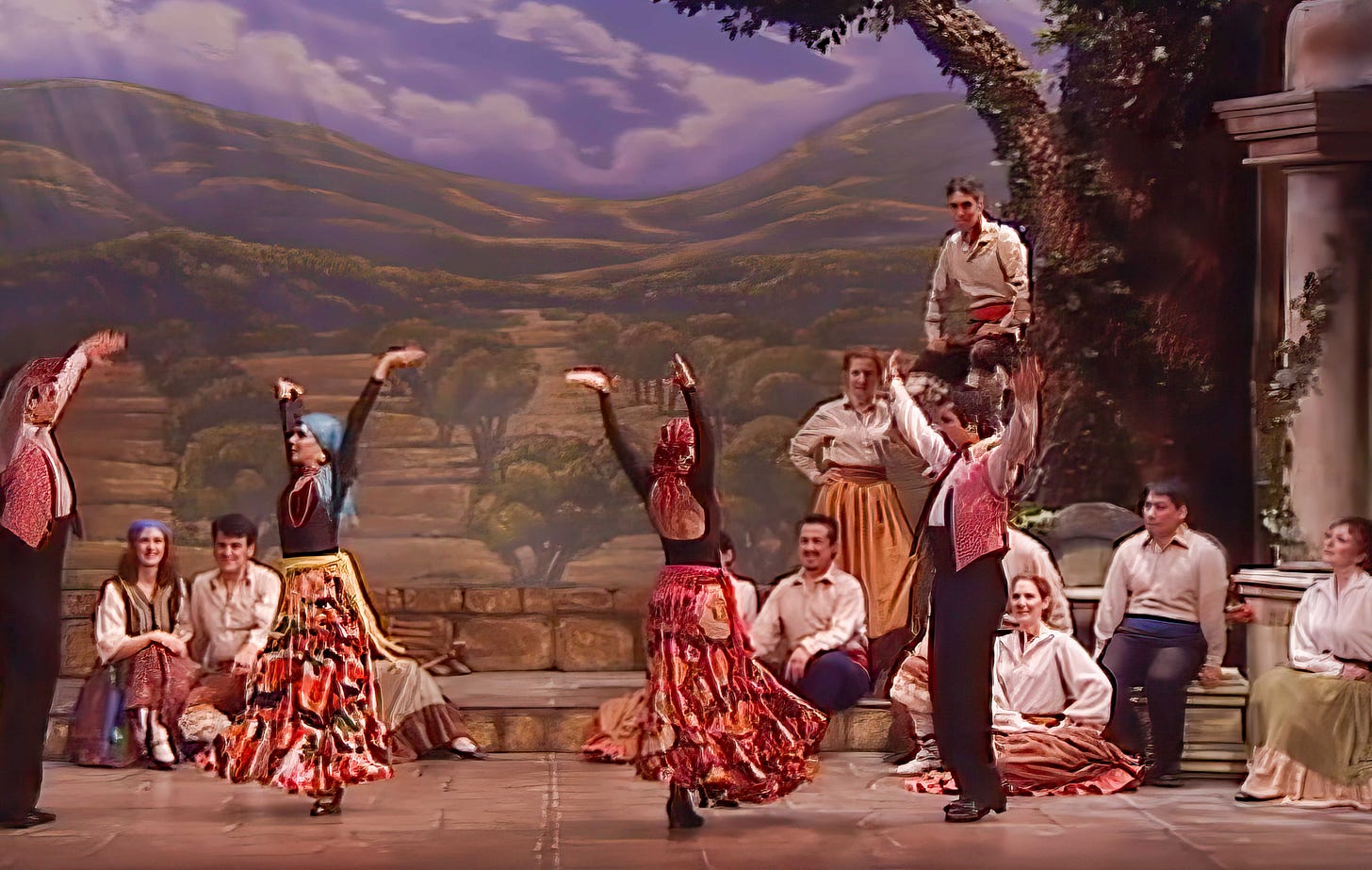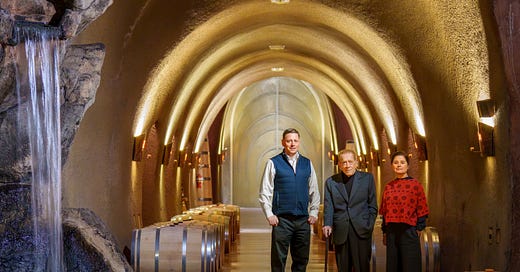NAPA, Calif. — Zarzuelas, the lively and colorful street operas of Spain, return to the Jarvis Conservatory in a new film festival taking place Aug. 11-13. Showing a selection of film versions of the productions William and Leticia Jarvis presented at the theater between 1995 and 2008, it will also be a celebratory reunion of many of the artists — musicians, singers, dancers and designers from Spain and around the world — who came to Napa to create a full-length zarzuela each summer.

Zarzuelas are “the best kept secret of music,” William said when he and his wife decided to bring them to a stage in Napa nearly three decades ago. “Zarzuelas are more melodic and more fun than Italian operas.” And unlike grand opera, which often focuses on kings, queen and Nordic gods, the Spanish zarzuela drew its inspiration from ordinary, often working-class people in real-life situations with lots of singing, dancing, comedy and “emotions like we all have.”
Every year as they assembled an international team of artists to create a zarzuela they also made high-definition DVD recordings of each production, now available on YouTube and Amazon. Nonetheless, he said, people have often asked him when they might bring zarzuelas back to the Jarvis Conservatory.
William, now 97, decided this was the year. “The Jarvis Conservatory was built to present zarzuelas,” he said.
Discovering zarzuela
The Jarvises and their young son, Will, discovered zarzuelas during extended stays in Europe to study culture, history and languages. Their intention was to focus on French literature, and they bought a chateau in Champagne while they pursued their studies. They also spent time in Spain. Leticia, who was born in Puebla, Mexico, inspired their interest Spanish culture, and they studied Spanish literature at Salamanca, the oldest university in Spain. As they explored Spain they found zarzuelas.
“Zarzuela originated in Spain in the 17th century but reached its definitive form in the 19th century as a mixture of instrumental music, singing, dancing and the spoken word that encompassed the rhythms and traditions of the diverse cultures of Spain. Today the form and tradition of zarzuela is firmly established, based on styles developed in the years before the Spanish Civil War in the 1930s,” John S. Wilson wrote in an article in The New York Times in 1983. He was reviewing a production called “Vive la Zarzuela,” a “potpourri of arias, duets and trios,” in a production that he found “indicated some of the styles involved in zarzuela and suggested the flavor of the genre.”
The Jarvises had something different in mind — to bring full-scale productions to their new home in Napa Valley, where they had decided to build a winery in the east Napa hills.
This winery project, developed with the late winemaker Dimitri Tchelistcheff, was another aspect of William’s Renaissance-man approach to life — to find a subject and embrace it by plunging into a deep study of all he could learn about it.

William was born in Oklahoma, and after attending the U.S. Naval Academy at Annapolis he served in the U.S. Navy, which sparked his interest in telecommunications. After his service, he continued his studies at UC Berkeley and Stanford and went to work at Hewlett-Packard in the vanguard of the high-tech innovations from Silicon Valley that would transform the world. He formed his own telecommunications company, Wiltron, and as his company thrived, he found opportunities to explore other interests that included travel, languages and the humanities.
He traveled through the Amazon rainforest, met elephants in Thailand, had a romance in Italy and then, studying Spanish language and literature at the University of the Americans in Mexico, he met Leticia.
Their time in Europe also sparked an interest in wine, and in 1986 they purchased a weekend home in Napa. This led William to a study of grape-growing and winemaking and the decision to build a winery. In 1990 he announced a merger of Wiltron with the Japanese company Anritsu. In his autobiography, “Three Generations, Adventures in a Changing World,” he wrote that this liberated him from managing the company, leaving him free to concentrate on other interests, including wine.
The Jarvis Winery created an underground world that contained the winemaking facilities, administration and hospitality areas, including a ballroom. The design preserved the outside landscape, and even inside the winery they incorporated an underground creek and waterfall. David Thompson, author of The Napa Wine Project, writes that of the 1,320-acre estate, only 37 are planted to vines, and the winery “is arguably one of the top five most interesting winery caves in all of the Napa Valley.”
While the innovative, state-of-the-art Napa winery was under construction, Leticia discovered another, entirely different Napa winery. The historic Lisbon Winery, built in the 1882, was the last native stone winery in the city of Napa, according to the Native Sons of the Golden West, who placed plaque on the site in 1978.
“Built and operated by Joseph Mathews (Mateus), a native of Portugal, this winery produced a variety of wines, including prize-winning sherry. Mathews was a pioneer in the exportation of fine Napa wines to Europe,” their information reads.
Made of stone quarried in the east Napa hills, the two-story building filled a city block at the corner of Main and Brown streets. It was a remanent “of the 1880s when Napa County was at the height of its viticultural period and a half dozen wineries, of brick and stone, were operating within the City of Napa,” the Native Sons wrote.
It had endured rough times when Leticia found the gutted stone building. Sold to new owners, it had shut down during Prohibition and later become a restaurant that also closed amidst rumors of money-laundering. By the 1990s it was an abandoned site, “except for gangs that stayed there,” William said. As they investigated the building’s story, Willliam said they learned that at one point during gang fights, one side had tried to burn down where their rivals were staying, “which wasn’t very smart since it was made of stone.”
The Jarvises bought the ghost winery and began the painstaking work of transforming it into a 200-seat theater that could be the stage for zarzuelas and performances of another art form they enjoyed, Baroque ballet. The first performances there, however, were by Tuna, a group of musicians, “most college students,” from Mexico City, who play classical music.

“If any of you think that classic music is OK but for someone else, be prepared for a surprise,” William wrote in “Three Generations.” Tuna’s music, he wrote, was “based on hundreds of years of tradition. It is authentic Spanish music, played with traditional instruments” — very much like the zarzuelas they would soon be producing.
Of the renovation project, William wrote, “I had a lot of fun designing and building the conservatory, although paying for it was not much fun. Friends from San Francisco have referred to the theater as an acoustic jewel, and for this I thank my wife, Leticia, who first saw the potential of these 22-inch-thick walls … I did my best to carry on the tradition started by the original Portuguese stone mason and sherry-maker Joseph Mathews. We did it so it would be a lasting memory to my family and so it would fulfill its function of fostering the fine arts. Most of us agree that ‘Man does not live by bread alone.’”
In addition to zarzuelas and ballet, the Jarvis Conservatory has hosted an annual Puppet Festival and an Arts Film Festival as well as performances by the Napa Valley Youth Symphony. It regularly screens award-winning international films and hosts a monthly musical series, “It’s a Grand Night for Singing.”
William and Leticia’s son, Will, who is now president of the Jarvis Winery, said he intends to continue his parents’ tradition of supporting the arts at the conservatory they built.
The Zarzuela schedule
When they decided to stage zarzuelas in Napa, William plunged into research.
“I discovered a much larger world of music literature than I had ever imagined,” he wrote in “Three Generations.” “Of the 10,000 zarzuelas that are indexed, there are 1,000 or so still considered in the available literature; of those, some 200 are active in today’s productions. All these are ‘classics’ in that they have stood the test of time. The fact that they are still around shows them to have a universal story and music. My challenge, after getting this far, was to narrow this down to a couple of dozen that I could reasonably expect to do soon and then to translate them into English and adapt the libretto for our American audience.”
This year’s inaugural screening of some of the productions they staged narrowed the list again when they chose some of their — and audiences’ — favorites.
The Zarzuela Film Festival opens on Friday, Aug. 11, at 7 p.m. with live singing, followed by a screening of “La Verbena de la Paloma,” which Leticia said “is one of the most popular zarzuelas.” It’s the story of people in Madrid preparing to go to the Festival of the Virgin, “full of humor and beautiful arias.”
On Saturday, Aug. 12, beginning at 7 p.m., the festival will first present dancers with Spanish guitar music and a presentation on Spanish dancing and its influence on zarzuelas. This night will show two zarzuelas, “Luis Alonso” and “La Alegría de la Huerta.”
“Luis Alonso is an important figure in Spain because he is a dance instructor,” Leticia said.
This work, about his marriage to a younger woman, is rich with dance — and comedy — as everyone prepares for the wedding. “Le Alegria de la Huerta” (“The Joy of the Ranch”) is a one-act comedy featuring a “rag-tag band” in rural Murcia, Spain.
“When we saw these in Madrid, William said, ‘I am going to combine them!’” Leticia said. “He was very bold, I think, but it was so well received.”
On day three, Sunday, Aug. 13, the festival runs from 2:45 to 5:30 p.m. and features “La Grand Via,” which Leticia described as “a classic with a lot of political action and satire” as people in Madrid look forward to a new grand boulevard.
Tickets are $25 for one day and $60 for a three-day festival pass. For more information or to purchase tickets, visit jarvisconservatory.com or call 707-255-5445. The Jarvis Conservatory is at 1711 Main St., Napa.
Sasha Paulsen is a journalist and novelist who lives in Napa.






Great story! I thought I knew something about the Jarvises, their winery and theater, but I learned far more.
The Jarvises are truly community benefactors. Like John and Michele Truchard and George Altamura, they bought and maintain treasured elephants for the rest of us to enjoy.